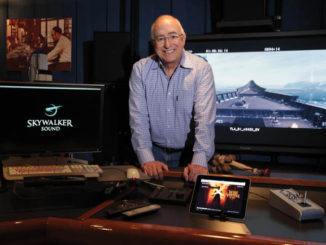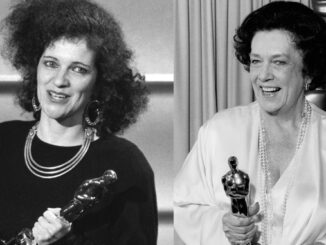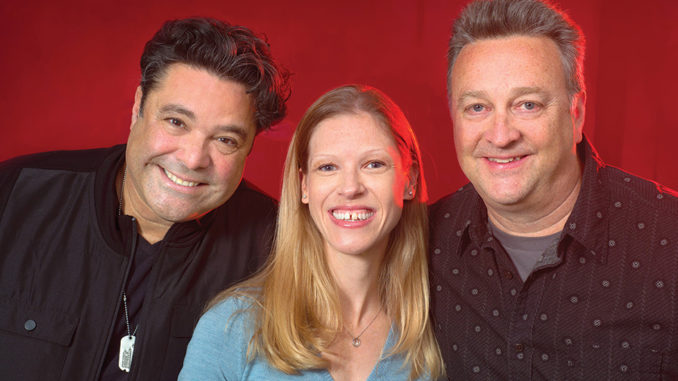
by Mel Lambert • portraits by Martin Cohen
Inspired by the Sabrina the Teenage Witch comic book series from Archie Comics — published intermittently between 1971 and 2009, and turned into the eponymous television series that aired 1996-2003, itself spawning a live-action and an animated TV movie — Netflix’s Chilling Adventures of Sabrina is the latest chapter of the young character, whose first appearance was in the October 1962 issue of the Archie’s Madhouse comic series.
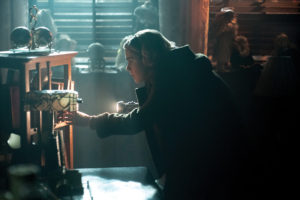
Netflix
Fifty-eight years to the month of her first guest-starring role in the comics, Sabrina returned with Chilling Adventures, a reboot that debuted on the streaming service in October 2018. A more gothic take on the characters and settings found in the comic book or the original series, Chilling Adventures is produced by Warner Bros. Television. The show has attracted a committed audience since the streaming of its first 10 episodes, which focused on Sabrina Spellman (Kiernan Shipka) during her teenage years in the 1970s. This was followed by a stand-alone Christmas-themed episode.
The remaining nine episodes of the first season will drop this April 5, and will be listed as Part Two. Part One of the series received positive reviews, with critics praising Shipka’s performance, as well as the premise, visuals and direction of the show — dark, coming-of-age story in which Sabrina reconciles her dual nature as a half-witch, half-mortal, while fighting evil forces that threaten her and her family. Netflix has already renewed the series for a second season of 16 episodes, which also will be split into two parts.
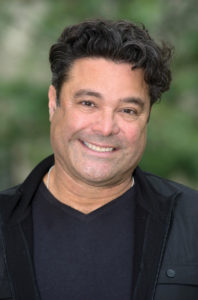
Post-production sound for Chilling Adventures is done on Stage 5 at Technicolor at Paramount by supervising sound editor/sound designer Edmond J. Coblentz, Jr. and his team, working closely with dialogue/music re-recording mixer Vicki Lemar and sound effects re-recording mixer Ken Kobett. As Coblentz tells it, “Executive producer Roberto Aguirre-Sacasa and his co-producer, Amy Myrold, brought Sabrina to us at Technicolor. The process of securing their overall visions for the soundtrack began with collaboration between the picture editors and myself.” >>>
“We put together the story visually and translate the specific sound designs and tone expected for the final mix in 5.1,” he continues. “We found that the first few episodes needed to be heard in a different scope because our showrunner/writer/creator wanted to hear the dialogue loud and present. To accomplish a successful and pleasing playback, we switched to stereo Left/Right, then back to 5.1 to make adjustments.”
To break down sound editorial assignments before they were turned over to the show’s dialogue, ADR, effects and Foley editors, each episode was first spotted with the producer and picture editor of that episode. “This is important because we form the acoustic draft of sound effects and music against our dialogue tracks,” Coblentz explains. “Production dialogue is edited and ADR added when needed. Since our show is a collaboration of highly talented artists, that draft becomes similar to musicians writing a song.
“At the end, our collaboration becomes very important for the final presentation, like a well-written tune,” the supervisor adds. “In terms of workflow, the editorial process for Sabrina is organized and presented like a feature film, with sound design playing a key part in the overall soundtrack. Our picture editors feed us the ideas like a pencil drawing, and then we take the canvas and begin painting the sound colors.”
A 20-year post-production veteran, Coblentz worked previously on Star (2016-present), Forever (2018) and Knightfall (2017-persent). As well as supervising Chilling Adventures, he also serves as the show’s co-sound designer. “I’m lucky to have sound designer Stuart Lloyd Martin at the helm,” Coblentz says. “With over 20 years of experience, Stuart has the precise taste and technical style to successfully collaborate with Ken Kobett. We use over 100 tracks peppering in between dialogue and music. My role of sound designer is simply to add colors of sound in the mix to complement our music and design.”
Dialogue for Part 1 was cut at Technicolor by Patrick Hogan, with Jane Boegel handling Part 2. “Production dialogue offers its own challenges,” Coblentz attests. “Almost every interior has a fireplace, because those visuals are very important for the décor of the show’s houses. The technical effects to create large, blazing fires usually are provided by gas lines that can create loud hissing noises [which are removed using a Sonic Studio NoNOISE plug-in]. “Of course, what we cannot save in production we replace with ADR; we work with the actors, mostly via ISDN since they are on set in Vancouver.”
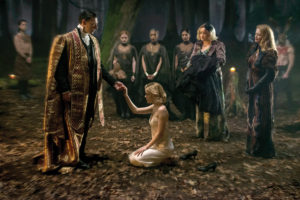
Netflix
Foley is a “major player to our sonic build,” adds the sound supervisor. “The team [headed by Foley editor/mixer Antony Zeller, CAS, MPSE] is responsible for covering all principal steps and movements, and then a pass of props. We will edit footsteps and props to sync up perfectly with the picture and production elements. We are lucky to have Robin Whittaker as our music editor; she has an extensive résumé working on big-budget features and television. Her music tracks are prepared for our mixer with direction and versatility.”
The sound team’s toughest hurdle for Chilling Adventures is the sound effects build, which requires extreme dramatic control and design of multiple mono and stereo tracks, according to Coblentz. “Stuart is also our key effects editor,” he says. “In order to get through a 55-to-60-minute show in a single 12-hour shift, his ability to prepare such large sessions is essential for our effects mixer, who receives 40 tracks of effects, 16 of sound design, 48 of backgrounds and 12 of Foley.” The elements are grouped together by sound events on Avid Pro Tools timelines.
When the show reaches the re-recording mixers, they develop an overall balance between dialogue, music, effects and Foley on the first day, according to Coblentz. “After the first couple of episodes, Vicki and Ken learned what the producer wanted in terms of style and sound levels. I create a master Pro Tools session of all those units, adding alts and missing elements, or editing missing material,” he explains. “Day two is a technical playback and then the producer’s playback. Both will have notes with regard to production, ADR, sound effects and design alts. I will edit what’s needed as we move through our notes. That is also for fixes and the final mix, with deliverables. Parts One and Two are very consistent in style and levels; we try not to make any changes to the established locations.”
A Balanced Mix
“We didn’t have a lot of discussion prior to mixing our first episode,” remembers Lemar, adding, “Edmond relayed to us the spotting notes from Roberto and we were given a sandbox to play in. There are key moments where we stay close to what everyone is used to hearing in the picture editing room, but we are able to support and enhance all that. And it was well received.”
The series represents a fantasy drama that follows the lead character as her 16th birthday nears, and Sabrina must choose between the witch world of her family and the human world of her friends. The pace of the soundtrack must leave room for high-impact sound as well as quieter, more reflective scenes. And the exact time period has yet to be determined.
“The year in which the series is set is a great question,” Lemar concedes. “The town of Greendale seems to be a time capsule. At the Spellman Sisters Mortuary they have record players, tube radios, old black-and-white TVs and a wall phone with a mallet-and-bell system on top of the handset. Dr. Cerberus’ book store houses a big jukebox, yet a very modern espresso/cappuccino machine. But Sabrina’s boyfriend drives an old truck and has a smart phone. From a sound standpoint, we treat everything as it is presented visually.”
Lemar continues: “As far as dynamic range goes, the showrunner really likes everything to play big and also loves the scare moments. Most of the episodes are very dense, which makes it challenging to make the big moments have an impact. But we find ways to get it done!” she adds.

“The main discussions dealt with track count and layout format,” Kobett remembers. “It was important to have editorial keep sound design on set tracks, separate from general hard effects because the show has many big scare moments that evolved over the course of several episodes. Also, with only about 14 hours total to mix episodes averaging 52 minutes, the schedule had to be well laid out.”
Lemar and Kobett work at an Avid Euphonix S5 digital console with 32 faders per side, each handling 304 inputs and JBL 5000 Series audio reference monitors. “Ken and I mostly work together during the first pass,” she explains. “We’ll roll through a scene listening to just the dialogue and music to get an idea of what the dialogue sounds like, and what the music is doing. Because he’s set up to work in-the-box, Ken can jump off-line and get backgrounds in the ballpark while I do a pass or two on dialogue for that scene. On my music pass, he’ll jump back on-line and rough in the hard effects or Foley and take another pass or two to finish up any loose ends. Then we move on to the next scene.”
“I would love to have time for pre-dubs,” Kobett laments. “We lock up together but have the ability to un-hook Pro Tools playback via Avid Satellite and write automation off-line; I do this constantly. I’ll preview levels, EQ and reverb settings while Vicki is rolling on dialogue. I write the preview, jump back on line to lock up with the scene and then mix fader levels.”
On the dialogue/music side, Lemar uses a Pro Tools template that accommodates 10 tracks of group ADR, 10 tracks of principal ADR, nine tracks for production, one for production futz and two X tracks. “Any ADR alt tracks are left inactive and hidden, where they can easily be dragged into active tracks for auditioning,” she explains. “For this show, score stems fit very nicely into two sets of eight stereo tracks, A and B. Needle-drops are anywhere from one to four stereo tracks.”
“Music really sets the overall tone of the show, while effects ground the dialogue and give ambience support,” Kobett offers. “The big scare moments get to be really big on the effects side. Roberto also likes it gory; the gushier the better. The quieter moments, specifically when the actors whisper, are difficult due to noise. With a lot of practical fires, the gas hiss is quite pronounced; because Roberto did not want to add fire crackle effects there was a ton of de-noising for Vicki. In those areas I would introduce more ambience to help mask the noise.”
The mix team prints to a 5.0 dialogue stem and a 5.0 group stem, plus 5.1 effects, Foley and background stems. “I have internal bussing for my dialogue chains; outputs feed these two stems on the master recorder,” Lemar explains. “I use a single 5.1 buss for music, although there have been a couple of instances of singing, for which I’ll print the vocals to a separate 5.1-channel stem. This means that the international mix has the flexibility to dub a foreign talent singing, or to use the English version.”
With dialogue panned primarily into the center channel, she uses the fronts and surround channels mostly for reverb. “I’ll pan dialogue left/right for off-screen lines coming from another room, or pan from left/right to center if a character is walking into frame — as long as it doesn’t take the audience out of the scene. There have been some opportunities to fly dialogue around the room during chants and spells, which is always fun.”
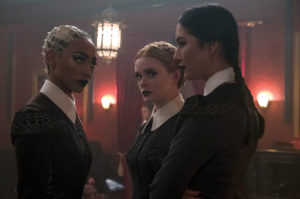
Netflix
Her main dialogue reverb is Audio Ease’s Altiverb plug-in. “I use mono, stereo and 5.1 output reverbs, depending on what the scene calls for,” she says. “I have about a half-dozen programs that I use regularly. I also use the console panners to spread the music; there’s no concern about how it will fold down, which is great. And I use Altiverb and Revibe II for music reverb.”
To streamline and categorize the effects build, Kobett and the lead effects editor discussed track layout after the first few episodes had been mixed. “It was an easy task as Lloyd really does an outstanding job keeping things organized,” Kobett says. “I had some personal preferences and there were elements that I knew we could cut back — like fire options. For hard effects, I receive around 35 monos, 12 stereos and 10 design stereos. Backgrounds are three sets of eight stereos and eight monos per set. Foley is 12 mono tracks. I also carry a pair of 5.1 tracks for main title effects and occasional pre-dubbed effects.”
“Effects generally live within music [until the mix becomes intense],” Kobett adds. “There is always a battle for sonic real estate between effects and music; this show is no different. But we manage to play together nicely.” According to the mixer, with discrete left and right rear surrounds for the master balance, the mix gets a nice surround pocket when decoded to 5.1. “We have to be extra careful that the stereo mix folds down clean,” he says. “Because Roberto likes to screen the show in stereo, the surround material is always checked to make sure it does not overload that mix. Like Vicki, my favorite reverb is Altiverb, which I use on hard effects, Foley and backgrounds. I switch between stereo and 5.1 outputs.”
Collaboration is King
Lemar considers Kobett to be a collaborative mix partner. “We have very similar mixing styles, which really helps us be quick and efficient,” she offers. “We only have two days to get 50 to 65 minutes of runtime mixed, played back and out the door. During our first pass of a scene, when we’re running with just dialogue and music, Ken is really focused on the story and how he can elevate it with his tracks.”
“Vicki and I teamed up last year, and I couldn’t be happier,” Kobett confirms. “She is fantastic with dialogue noise reduction, ADR matching and music. As a mix team, personality and workflow are really crucial to a harmonious stage. And Eric Huzeo, our stage tech, is a crucial part of that team dynamic. He is first-in, last-out and a constant positive force.”
In terms of on-stage negotiations between dialogue, music and sound effects, “Whoever has the sharpest and loudest zings, bangs or booms wins,” Lemar concedes. “Our effects editor does a really great job of having all the big moments covered, because he doesn’t know what the final music will be doing. When we receive the music from our incredibly talented composer, Adam Taylor, we have nothing but great choices.

“Sometimes, we choose to feature the effects a little more; sometimes music is really propelling and commenting on the scene, and we can use effects to support and supplement,” she continues. “It all depends upon what’s happening on screen. We do our initial pass in 5.1-channel and, at our showrunner’s request, play back the two-track left/right derived simultaneously from the 5.1. Usually there aren’t any surprises in the down mix. And since most of the playback notes are minor level adjustments, we know what we do in the two-track will translate back to the 5.1.”
Lemar relates that Netflix recently changed its audio delivery specifications to -27 dBFS on a dialogue-weighted scale, according to the ITU-R BS.1770-1 algorithm. “Most network and cable shows measure overall loudness with a target of -24 dBFS to ITU-R BS.1770-3,” she says. “We check our levels after our technical playback during the morning of day two. If we need to make any adjustments, we can do that while addressing the first round of notes. We then do a final check after the playback for our showrunner to make sure we’re still in spec.”
Most of the playback notes were to make things louder, according to Lemar. “We had a note recently to turn down a sting, and the showrunner prefaced it with, ‘I can’t believe I’m actually going to give this note.’ Roberto wants the dialogue to pop and our mix to jump at the scare moments. If we get an audible reaction from him during playback then we know we’ve done our jobs! Our mission is to make sure the dialogue stands out in the mix. There are lots of exterior scenes that are quite noisy; it’s all about how much noise you can clean out without sacrificing clarity. Or maybe getting the dialogue to cut through when a tornado is ripping through town.”
Reviewing his experience with Part 1 of Chilling Adventures, Coblentz considers meeting the show’s schedule to be the most daunting task. “Each episode is a mini-feature with running times between 55 and 65 minutes,” he says. “Our timeline to turnover is 20 episodes, back-to-back. And Netflix has just ordered an additional 16 [for the second season]. These timelines are normal in the primetime slots of 42-minute programs. But add more time to the story, and no commercials, and you have…streaming broadcast at its finest!
“My editors, recordists and mixers all work under the highest levels of expectation,” he concludes. “We have developed a well-oiled machine on the show that never ends!” Perhaps Sabrina has cast a sonic spell on them as well.




